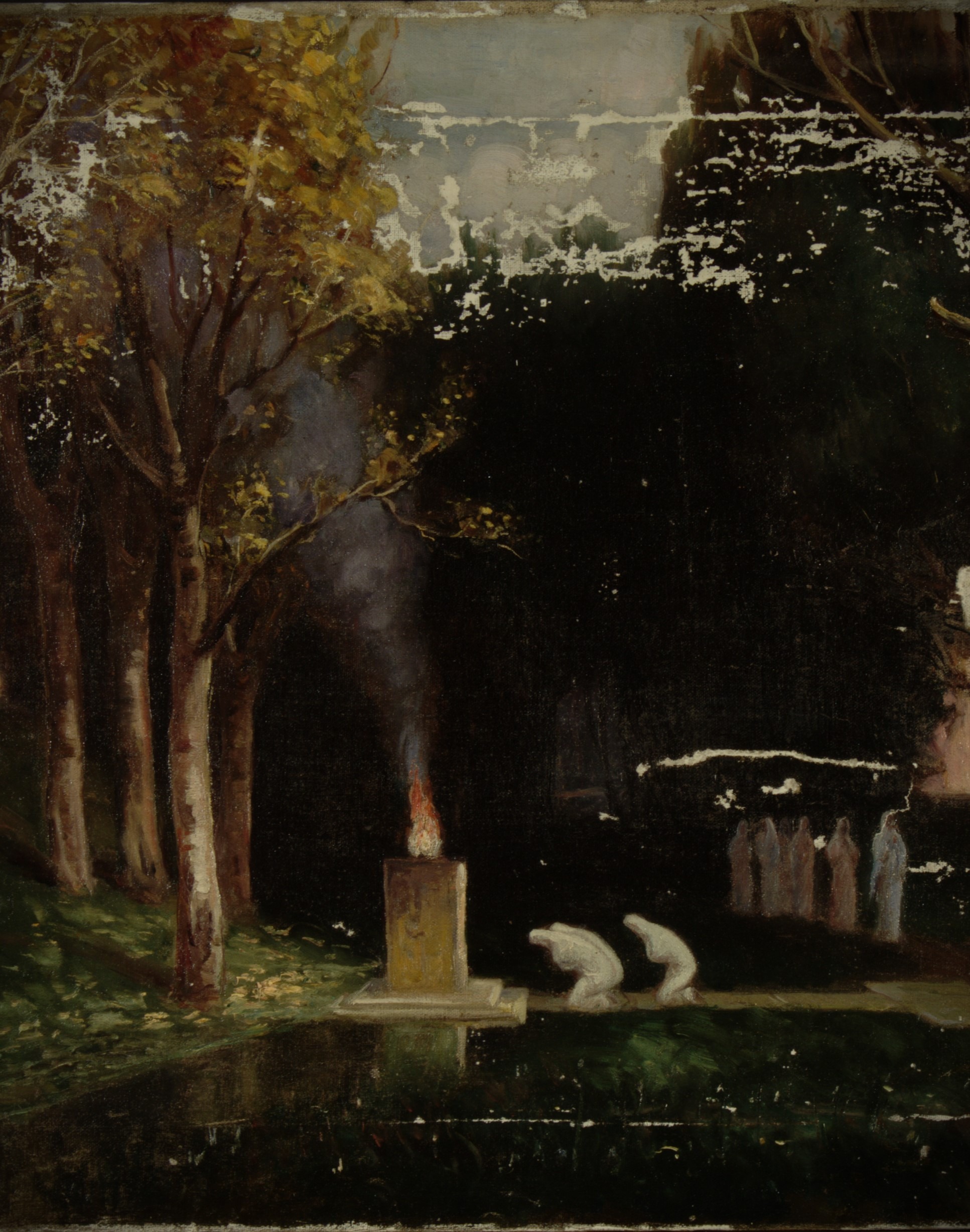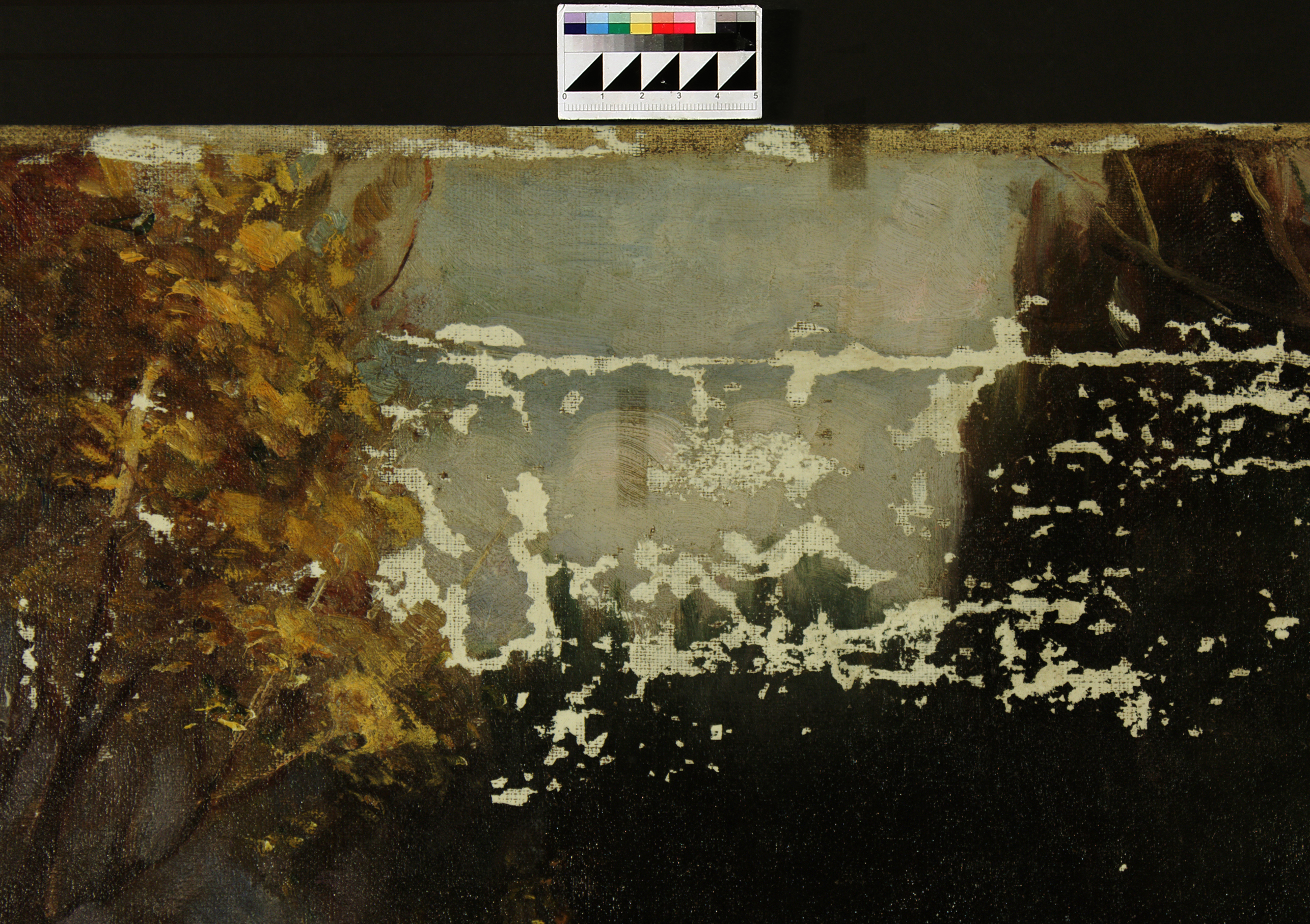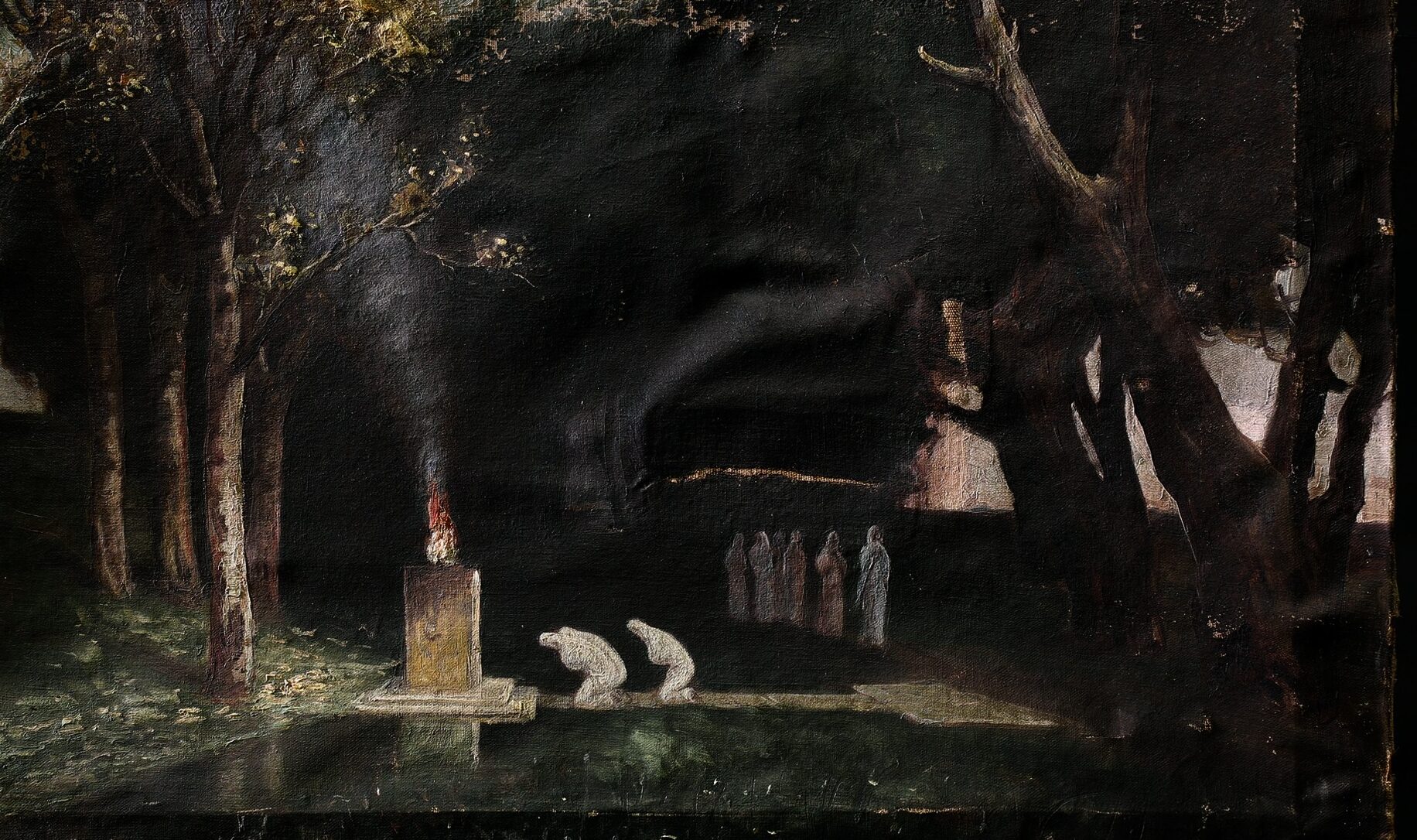Restoration of
the painting
"Sacred Grove"
Works of oil painting from
the time of mastering this
technique to the present day
are the pride of the
greatest museum collections

From the moment the material and spiritual value of works of art was realised, work began to preserve them from the effects of time. Perhaps a pattern can be deduced here: the level of cultural and aesthetic development of a society is adequate to the efforts it makes to preserve its national treasures.
For the uninitiated, restoration may seem to be only a narrow, purely applied field of “subduing” works of art that have fallen into disrepair. However, this is not the case. Over time, as restoration has evolved, without losing its original purpose, it has become a complex set of scientific and artistic disciplines.
Modern restoration is as much about saving monuments as it is about studying them in depth. And it is not only the study of the physical and chemical properties of the multi-layered structure of paintings, but also their stylistics, execution techniques, history of creation, etc.
The fundamentals, nature and methods of restoration of architecture, sculpture, graphics, oil and tempera painting have undergone all kinds of changes in their historical development. This path is most fully revealed in the history of restoration of easel oil painting. Works of oil painting from the time of mastering this technique to the present day are the pride of the greatest museum collections.
The painting came from a private collection, was previously under restoration, the restorer is unknown. The history of the monument is unknown. The state of emergency.
Copy
Name of artist: I. Gromov
Title of artwork: Sacred Grove
Year created: 1914
Medium & materials: Canvas/oil
Dimensions: 60 x 86 cm
Location: Private collection
Original:
Name of artist: A. Böcklin
Title of artwork: Sacred Grove
Year created: 1886
Medium & materials: Wood panel/oil
Dimensions: 150 х 100 cm
Location: Kunsthalle museum
Analysing the condition
of the painting before starting restoration work
First of all, the painting is badly deformed. There are losses of the ground and paint layer at all corners and on the fold of the canvas, and all around the perimeter, in the central part of the image there are losses to the base, a cut with shrinkage. The painting needs restoration before the process of destruction of the painting becomes irreversible.
Analysis of the work
This is a copy of the painting “The Sacred Grove” by Arnold Böcklin, a Swiss painter, graphic artist and sculptor, one of the most prominent representatives of symbolism in 19th-century European fine art of the Düsseldorf school of art, painted from a small postcard (found behind the stretcher at the back of the painting).
He studied at the Academy of Arts in Düsseldorf with the historical painter F. T. Hildebrandt and landscape painter I. W. Schirmer (1845-1847), then in Munich, where he attracted the attention of Count Schuck. He undertook educational travelling in Switzerland, the Netherlands and France. Initially engaged in landscape painting, but in time moved into mythological subjects. From 1850-1857 he worked in Rome. In 1860-1862 he was a professor at the Academy of Arts in Weimar. In his last years he worked alternately in Basel and in Italy. He influenced such representatives of Surrealism as Max Ernst, Salvador Dalí and Giorgio de Chirico.
Composition and sequence
of restoration measures:
- Dedusting
- Strengthening of the ground and paint layer
- Removal of the painting from the stretcher
- Removal of old restoration patches
- Cleaning the surface of the painting from the back side
- Stretching the painting on a working stretcher
- Eliminating deformations and shrinkage of the canvas
- Replenishment of canvas losses
- Duplication of canvas
- Stretching the painting on a new stretcher
- Regeneration of varnish
- Application of restoration primer within the limits of losses
- Elimination of surface contamination of the painting
- Coating the painting with a new restoration varnish
- Restoration of the painting within the limits of losses.
From the moment the material and spiritual value of works of art was realised, work began to preserve them from the effects of time. Perhaps a pattern can be deduced here: the level of cultural and aesthetic development of a society is adequate to the efforts it makes to preserve its national treasures.
BLOG
For the uninitiated, restoration may seem to be only a narrow, purely applied field of “subduing” works of art that have fallen into disrepair. However, this is not the case. Over time, as restoration has evolved, without losing its original purpose, it has become a complex set of scientific and artistic disciplines.
Modern restoration is as much about saving monuments as it is about studying them in depth. And it is not only the study of the physical and chemical properties of the multi-layered structure of paintings, but also their stylistics, execution techniques, history of creation, etc.
The fundamentals, nature and methods of restoration of architecture, sculpture, graphics, oil and tempera painting have undergone all kinds of changes in their historical development. This path is most fully revealed in the history of restoration of easel oil painting. Works of oil painting from the time of mastering this technique to the present day are the pride of the greatest museum collections.
Copy
Name of artist: I. Gromov
Title of artwork: Sacred Grove
Year created: 1914
Medium & materials: Canvas/oil
Dimensions: 60 x 86 cm
Location: Private collection
Original:
Name of artist: A. Böcklin
Title of artwork: Sacred Grove
Year created: 1886
Medium & materials: Wood panel/oil
Dimensions: 150 х 100 cm
Location: Kunsthalle museum
The painting came from a private collection, was previously under restoration, the restorer is unknown. The history of the monument is unknown. The state of emergency.
Analysing the condition of the painting before starting restoration work
First of all, the painting is badly deformed. There are losses of the ground and paint layer at all corners and on the fold of the canvas, and all around the perimeter, in the central part of the image there are losses to the base, a cut with shrinkage. The painting needs restoration before the process of destruction of the painting becomes irreversible.
Analysis of the work
This is a copy of the painting “The Sacred Grove” by Arnold Böcklin, a Swiss painter, graphic artist and sculptor, one of the most prominent representatives of symbolism in 19th-century European fine art of the Düsseldorf school of art, painted from a small postcard (found behind the stretcher at the back of the painting).
He studied at the Academy of Arts in Düsseldorf with the historical painter F. T. Hildebrandt and landscape painter I. W. Schirmer (1845-1847), then in Munich, where he attracted the attention of Count Schuck. He undertook educational travelling in Switzerland, the Netherlands and France. Initially engaged in landscape painting, but in time moved into mythological subjects. From 1850-1857 he worked in Rome. In 1860-1862 he was a professor at the Academy of Arts in Weimar. In his last years he worked alternately in Basel and in Italy. He influenced such representatives of Surrealism as Max Ernst, Salvador Dalí and Giorgio de Chirico.
Composition and sequence of restoration measures:
- Dedusting
- Strengthening of the ground and paint layer
- Removal of the painting from the stretcher
- Removal of old restoration patches
- Cleaning the surface of the painting from the back side
- Stretching the painting on a working stretcher
- Eliminating deformations and shrinkage of the canvas
- Replenishment of canvas losses
- Duplication of canvas
- Stretching the painting on a new stretcher
- Regeneration of varnish
- Application of restoration primer within the limits of losses
- Elimination of surface contamination of the painting
- Coating the painting with a new restoration varnish
- Restoration of the painting within the limits of losses.
The painting came from a private collection, was previously under restoration, the restorer is unknown. The history of the monument is unknown. The state of emergency.
Analysing the condition of the painting before starting restoration work
First of all, the painting is badly deformed. There are losses of the ground and paint layer at all corners and on the fold of the canvas, and all around the perimeter, in the central part of the image there are losses to the base, a cut with shrinkage. The painting needs restoration before the process of destruction of the painting becomes irreversible.
Analysis of the work
This is a copy of the painting “The Sacred Grove” by Arnold Böcklin, a Swiss painter, graphic artist and sculptor, one of the most prominent representatives of symbolism in 19th-century European fine art of the Düsseldorf school of art, painted from a small postcard (found behind the stretcher at the back of the painting).
He studied at the Academy of Arts in Düsseldorf with the historical painter F. T. Hildebrandt and landscape painter I. W. Schirmer (1845-1847), then in Munich, where he attracted the attention of Count Schuck. He undertook educational travelling in Switzerland, the Netherlands and France. Initially engaged in landscape painting, but in time moved into mythological subjects. From 1850-1857 he worked in Rome. In 1860-1862 he was a professor at the Academy of Arts in Weimar. In his last years he worked alternately in Basel and in Italy. He influenced such representatives of Surrealism as Max Ernst, Salvador Dalí and Giorgio de Chirico.
Composition and sequence of restoration measures:
- Dedusting
- Strengthening of the ground and paint layer
- Removal of the painting from the stretcher
- Removal of old restoration patches
- Cleaning the surface of the painting from the back side
- Stretching the painting on a working stretcher
- Eliminating deformations and shrinkage of the canvas
- Replenishment of canvas losses
- Duplication of canvas
- Stretching the painting on a new stretcher
- Regeneration of varnish
- Application of restoration primer within the limits of losses
- Elimination of surface contamination of the painting
- Coating the painting with a new restoration varnish
- Restoration of the painting within the limits of losses.

















